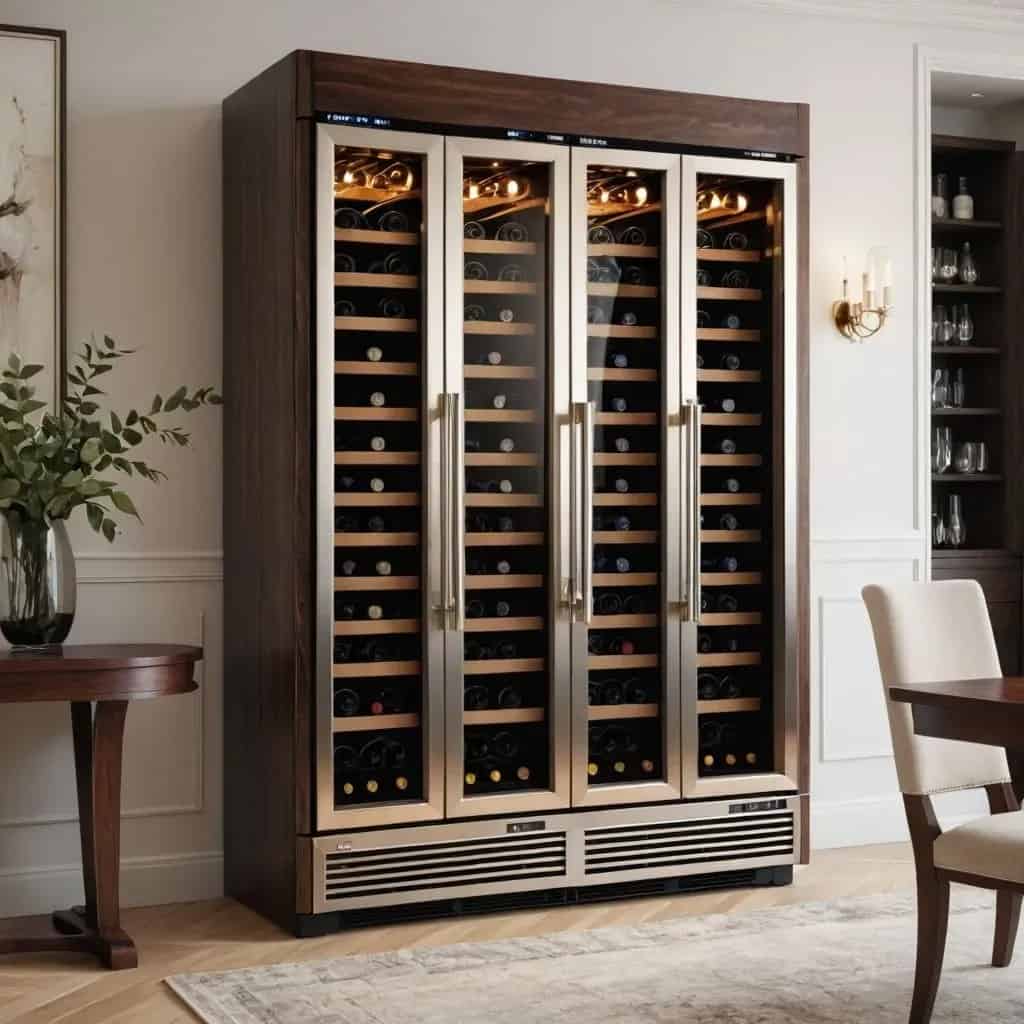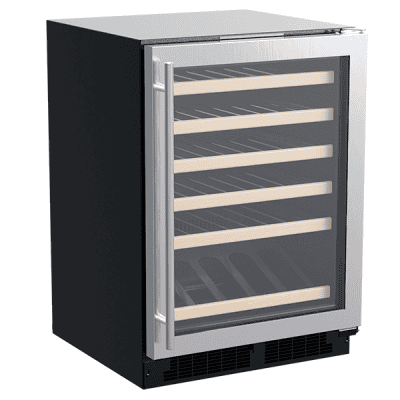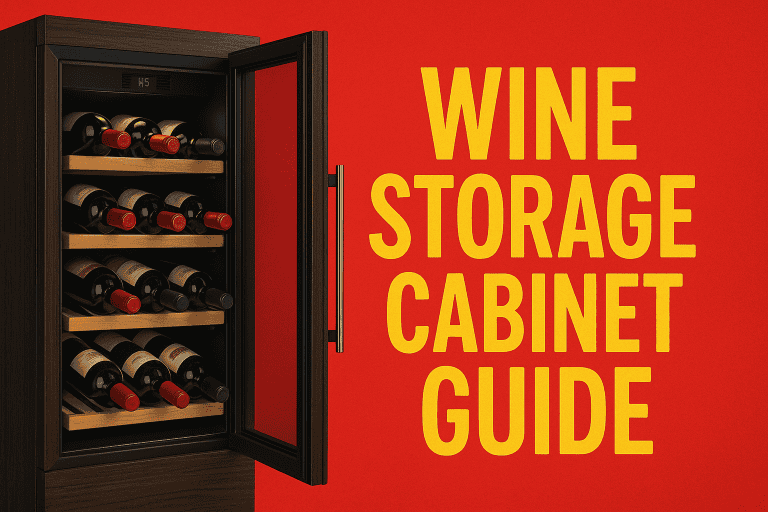Two contenders stand out as champions of beverage storage in home appliances: the wine fridge and the beverage fridge. While they may seem similar initially, these specialized units cater to distinct needs and offer unique advantages.
In this thrilling showdown, “wine fridge vs beverage fridge,” we’ll explore the nuances of each appliance and explain its strengths, features, ideal applications, and areas for effective utilization.
Get ready to discover the secrets to help you find the best solution for you.
Welcome to Didi Somm – let’s raise our glasses and Cheers!
Important Notice: The information in this article is for general and public information purposes only. It solely reflects Didi Somm’s or his Staff’s opinion, and no responsibility can be assumed for errors or omissions in the service’s contents. For details, please check the Disclaimer at the bottom of the homepage.
Key Takeaways
| Wine FrigdeBeverage Fridge | |
|---|---|
| Designed specifically for wine storage and aging | Designed for chilling a wide range of beverages |
| Maintain precise temperature (45°F – 65°F) and humidity (50% – 70%) | Temperature range of 35°F – 45°F for refreshing beverages |
| Offer UV protection and vibration minimization | Ample interior space for various beverage sizes |
| Ideal for wine enthusiasts, collectors, and commercial use | Versatile for homes, offices, and commercial settings |
| Options for wine presentation, tastings, and long-term aging | Outdoor-rated models for outdoor entertainment spaces, pool- & BBQ areas, etc. |

The Wine Fridge: A Connoisseur’s Companion
Wine fridges are meticulously designed to create the perfect environment for storing and aging wine. These appliances maintain precise temperature and humidity levels, ensuring that your prized bottles are preserved in their optimal state. Beyond their core functionality, wine fridges can provide a range of services tailored to wine enthusiasts and collectors:
Temperature Control:
Wine fridges typically offer a narrow temperature range between 45°F and 65°F (7°C and 18°C), catering to the specific requirements of different wine varieties. This precise temperature control is crucial for preserving your wines’ delicate flavors and aromas.

Humidity Regulation:
In addition to temperature, humidity plays a vital role in wine storage. Wine fridges maintain humidity levels between 50% and 70%, preventing cork shrinkage and oxidation, which can spoil the wine’s integrity.
UV Protection:
Exposure to UV light can degrade wine over time, altering its flavor and appearance. Wine fridges often feature UV-resistant glass doors or solid insulation to shield your collection from harmful light.
Vibration Minimization:
Excessive vibration can disturb the sediment in wine bottles, leading to a cloudy appearance and potential flavor alterations. Wine fridges are designed with vibration-dampening features to protect the delicate nature of your wines.
Wine Presentation and Display:
Many wine fridges incorporate sleek designs and artistic elements, such as wooden racks or LED lighting, allowing you to showcase your collection as a centerpiece in your home or wine cellar.
Wine Aging and Cellaring:
Specialized wine fridges with temperature and humidity controls tailored for long-term aging can serve as miniature wine cellars, enabling you to age your wines to perfection within the comfort of your home.
Areas of Use:
Wine fridges are primarily designed for indoor use in private homes, wine cellars, restaurants, and wine bars. Their precise temperature and humidity control make them unsuitable for outdoor or highly variable environments, as exposure to extreme conditions can compromise their performance and your wine’s quality.

The Beverage Fridge: A Versatile Refreshment Hub
Beverage fridges, however, are versatile appliances designed to chill a wide range of beverages, from soda and beer to juices and water. Their primary focus is on convenience and accessibility, making them suitable for various settings:
Temperature Range:
Beverage fridges typically offer a temperature range between 35°F and 45°F (2°C and 7°C), ideal for keeping drinks refreshingly cold and ready to enjoy.
Versatile Storage:
With their adjustable shelves and ample interior space, beverage fridges can accommodate a variety of beverage sizes and types, from cans and bottles to larger containers.
Easy Access:
Many beverage fridges feature glass doors or clear fronts, allowing you to quickly locate your desired drink without opening the fridge and letting cool air escape.
Compact and Stylish:
Beverage fridges are often designed with sleek, modern aesthetics and compact sizes, making them suitable for various spaces, including kitchens, home bars, entertainment areas, offices, and commercial settings.
Outdoor Capability:
Some beverage fridges are specifically designed for outdoor use. They feature weather-resistant construction and enhanced insulation to withstand extreme temperatures and environmental conditions.

Commercial Applications:
Beverage fridges are widely used in restaurants, bars, offices, and retail settings. They provide convenient access to chilled beverages for customers and employees.
Areas of Use:
Beverage fridges are versatile appliances used indoors and outdoors in private and commercial settings (with appropriate outdoor-rated models). Their ability to accommodate a wide range of beverages and compact size makes them suitable for homes, offices, recreational areas, and outdoor entertainment spaces.
FAQ – wine Fridge vs beverage fridge
1. Can I store wine in a beverage fridge?
While wine bottles can be stored in a beverage fridge, it’s not recommended for long-term storage or aging. Beverage fridges typically don’t offer the precise temperature and humidity control required for storing wine.
2. Can I store beer and other beverages in a wine fridge?
Wine fridges are designed specifically for wine storage and may not maintain the ideal temperature range for other beverages. However, some models offer separate compartments that accommodate a limited number of other beverages.
3. Which one is more energy-efficient?
Generally, wine refrigerators are more energy-efficient than beverage coolers due to their superior insulation and precise temperature control systems. However, energy consumption can vary depending on the model and usage patterns.
4. Do wine fridges have Interior lighting?
Many wine fridges feature interior lighting, often LED or soft ambient lighting. This illumination lets you easily view and showcase your wine collection without exposing the bottles to excessive light.
5. Can I install a wine fridge or beverage fridge under the counter?
Many wine and beverage fridges are designed for undercounter installation, allowing for seamless integration into your kitchen or home bar. However, ensure proper ventilation and clearance according to the manufacturer’s instructions.
6. How do I clean a wine fridge or beverage fridge?
Both appliances should be cleaned regularly to maintain optimal performance and freshness. Follow the manufacturer’s recommendations for cleaning procedures, which may involve removing shelves, wiping down interior surfaces, and cleaning the door gaskets.
7. Can I store open bottles of wine or beverages in these fridges?
While it’s possible to store open bottles in wine and beverage fridges for a short period, it’s generally recommended that they be consumed within a few days to prevent oxidation and flavor degradation.
8. How long do wine and beverage fridges typically last?
With proper maintenance and care, wine and beverage fridges can last several years. The lifespan can vary depending on the quality of the appliance, usage patterns, and environmental conditions.
9. Do I need a backup cooling system for a wine fridge?
For serious wine collectors or those with valuable collections, investing in a backup cooling system or power supply can protect against power outages or equipment failures.
10. Can I use a wine fridge or beverage fridge in an outdoor setting?
Most standard wine fridges are not designed for outdoor use, as exposure to extreme temperatures, humidity, and weather conditions can compromise their performance and longevity. However, some specialized beverage fridges feature weather-resistant construction and enhanced insulation.
11. What are some popular brands for wine and beverage fridges?
Some popular brands for wine fridges include Vinotemp, Wine Enthusiast, Eurocave, Kalamera, and NewAir. Well-known brands for beverage fridges include Danby, Frigidaire, Whynter, Magic Chef, and Avanti.
12. Can I store red and white wines in the same fridge?
Yes, most wine fridges can accommodate both red and white wines. However, if you have a diverse collection with varying temperature requirements, consider investing in a dual-zone wine fridge to maintain separate temperature zones for each type of wine.
13. How do I choose the right size wine or beverage fridge?
Consider the number of bottles or beverages you plan to store and any future growth in your collection. Wine and beverage fridges come in various sizes, from compact units holding a few dozen bottles to larger models accommodating hundreds of bottles or cans.
14. Can I use a regular refrigerator for storing wine or beverages?
While a regular refrigerator can provide basic temperature control, it’s not explicitly designed for wine or beverage storage. Regular refrigerators often lack humidity control, vibration dampening, and UV protection, essential for long-term wine preservation and optimal beverage chilling.
15. How do I properly age wines in a wine fridge?
For optimal aging, the wine fridge should maintain a consistent temperature between 55°F and 65°F (13°C and 18°C) and a humidity level of around 70%. Additionally, store the bottles horizontally to keep the corks moist and avoid excessive vibration or light exposure.

Conclusion:
Choosing between a wine fridge and a beverage fridge ultimately depends on your needs and priorities.
Wine fridges are the superior option for wine enthusiasts, collectors, and connoisseurs who prioritize preserving their prized wine collection’s delicate flavors and nuances through precise temperature and humidity control, UV protection, and vibration minimization. These specialized units create the perfect environment for long-term wine storage and aging in your home, wine cellar, or specialized wine establishment.
Conversely, if your primary focus is on having a wide variety of refreshingly chilled beverages readily accessible, a beverage fridge is the clear winner. With their versatile storage options, sleek designs, and ability to accommodate various beverage types and sizes, these fridges are ideal for homes, offices, recreational areas, and commercial settings like restaurants and bars.
Moreover, their outdoor-rated counterparts extend their usefulness to outdoor entertainment spaces and pool- & BBQ areas, ensuring a steady supply of chilled drinks in any environment.
Ultimately, carefully assess your specific beverage storage needs, the areas where you plan to utilize the appliance, and factors like capacity, energy efficiency, and installation requirements.
Cheers to finding the best “fridge” for you!
For your reference, the latest articles by “Didi Somm” include:
- From Wood to Stone – The Best 5 Wine Cabinet Materials for You
- How to Organize a Wine Cellar? – 9 Best Tips to Organize Your Wine Collection
- Wine Aging Made Easy: How to Use a Wine Fridge in Cellaring?
- What Temperature Should a Wine Fridge Be? – 7 Expert Tips
- Single Zone or Dual Zone Wine Fridge: How to Choose the Best for You?
- The Art of Wine Preservation: What is a Wine Fridge in 7 Exciting Steps
Important Notice: The information in this article is for general and public information purposes only. It solely reflects Didi Somm’s or his Staff’s opinion, and no responsibility can be assumed for errors or omissions in the Service’s contents – for details, please check the Disclaimer at the bottom of the homepage.







